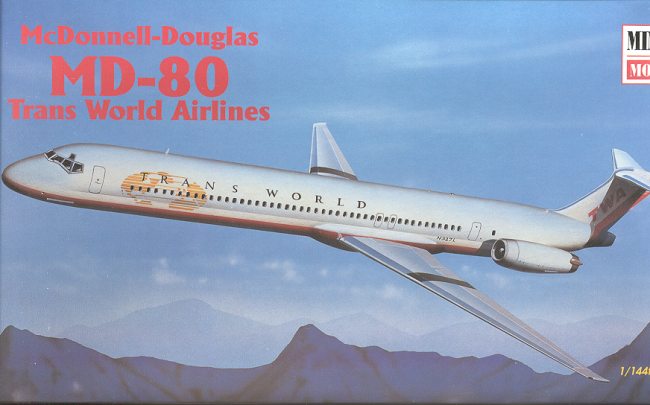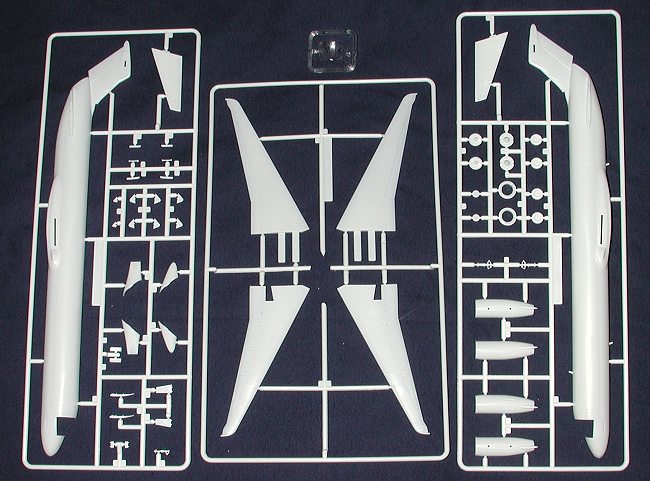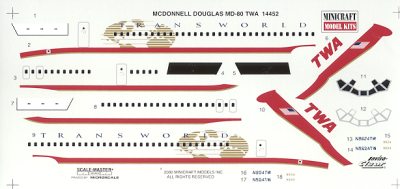
|
KIT: |
Minicraft 1/144 TWA MD-80 |
|
KIT # |
14452 |
|
PRICE: |
$16.00 |
|
DECALS: |
One aircraft |
|
REVIEW & |
|
|
NOTES: |
|

|
HISTORY |
The MD-80 was one of several extreme stretches of the venerable DC-9. Of course, by the time the MD-80 was being conceived in the mid 1970s, Douglas had been bought out by McDonnell and so the MD nameplate instead of DC. The MD-80 was really more of a second generation jet in comparison to the earlier DC-9s, regardless of the external similarities. Improvements in engines, avionics and instrumentation made this a much improved aircraft over the earlier versions.
The launch customer for the MD-80 series, in this case an MD-83, was Trans World Airways (TWA). By coincidence, St. Louis is the home of both McDonnell-Douglas and TWA, so that made things much more memorable. The MD-80 was a huge commercial success both here in the US and in overseas markets, working the short to medium range routes. TWA also put in the last order for MD-80s in 1998, rather fitting, don't you think? By the time production of the MD-80 had stopped in favor of the Boeing 717 (yet another DC-9 derivative and yet another takeover, so yet another name change), over 1,150 aircraft had rolled off the assembly lines.
|
THE KIT |

Those of you who have read my review of the Boeing 377 Stratocruiser are probably wondering why I went and bought another Minicraft airliner kit. Well, there are several reasons. First, the 377 was one of Minicraft's first forays into doing airliners, and though one would have hoped for a perfect kit, sometimes one doesn't get it in a first try. Second, I really like DC-9s and their derivatives. They are my favorite airliner. Third, this has TWA markings and TWA is a local company. Finally, I wanted to see what was so special about this kit the Squadron Mail-Order would name it kit of the year or 2001 before it even hit the market.
Opening the sturdy box, I was presented with two bags with white plastic in them, an instruction sheet and a decal sheet. First, the kit. Unlike the 377, the moldings are very crisp and flash free, as one expects nowadays. The detailing is, for the most part, engraved and well done. There are raised lines along the fuselage that I can only guess must be guides for the window decals. Parts are minimal as one would expect for an airliner kit, however, there is an optional tailcone for you to use should you desire. This is quite nice of Minicraft to offer this as many will want to use aftermarket decals that may have aircraft that use either cone.
One feature that is carried over from other Minicraft kits is the molding of the cockpit windows in with a larger clear section. While this does make for a cleaner window installation, some would rather have the clear bit separate as with the Airfix airliners. Since I generally have trouble with the upper seam on this type of arrangement, I would prefer it separate, but that is just my personal preference. Another preference of mine and one that is also not shared by all, it not having cabin windows on the fuselage. These are represented by decals. I prefer this method as I generally fill the cabin windows if they are offered and use decals. Others prefer the windows.
 The instructions
are rather basic, but quite adequate for the job. There are six construction
steps with color callouts given where needed. Colors are generic in this part.
The decal sheet is for two TWA aircraft, one with the pointed tail cone and the
other with the flatter one. The only decal change is the registration number.
The decals are by Scalemaster, and happily, are in register. In addition to
cabin window decals, cockpit window decals are offered, or you can leave the
cockpit windows clear and use the framing decal provided. The painting
arrangement offers FS numbers for the light grey and the dark blue. The dark
blue of the scheme will have to be painted. This will not be easy and I would
recommend photocopying the decal sheet and using the photocopy as a mask. Any
minor sloppiness will be covered by the cheat line, but it is red and red is
notoriously translucent to dark backgrounds.
The instructions
are rather basic, but quite adequate for the job. There are six construction
steps with color callouts given where needed. Colors are generic in this part.
The decal sheet is for two TWA aircraft, one with the pointed tail cone and the
other with the flatter one. The only decal change is the registration number.
The decals are by Scalemaster, and happily, are in register. In addition to
cabin window decals, cockpit window decals are offered, or you can leave the
cockpit windows clear and use the framing decal provided. The painting
arrangement offers FS numbers for the light grey and the dark blue. The dark
blue of the scheme will have to be painted. This will not be easy and I would
recommend photocopying the decal sheet and using the photocopy as a mask. Any
minor sloppiness will be covered by the cheat line, but it is red and red is
notoriously translucent to dark backgrounds.
Overall, the kit looks as if it would be a great build. While the kit itself appears simple enough, the decal/paint scheme is such that it will require some experience with airliner kits to do a good job, though it should be well within the realm of intermediate modelers.
Now for the big question. Is it worthy of Kit of the Year; 2001. From my viewpoint, no, but I'm not in marketing and I'm sure that they didn't want to put another Tamiya model on the cover!!
Review kit courtesy of me and my wallet!
If you would like your product reviewed fairly and quickly by a site that has over 1,700 visits a day, please contact me or see other details in the Note to Contributors.